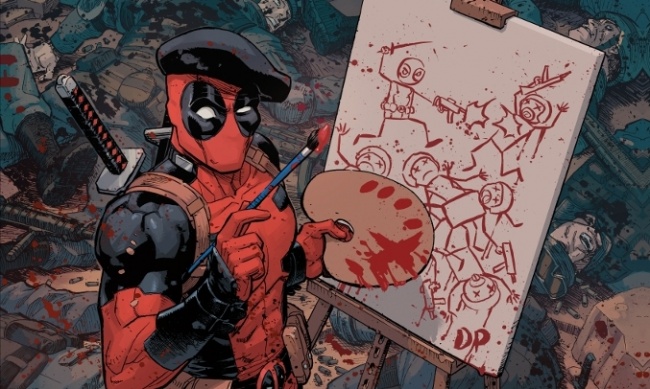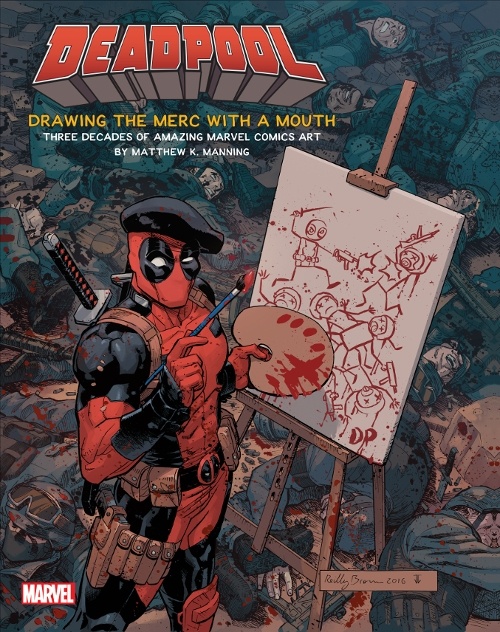Deadpool: Drawing the Merc with a Mouth--Three Decades of Amazing Marvel Comics Art HC
Publisher: Insight Editions
Release Date: October 25, 2016
Price: $45.00
Creator: Matthew K. Manning
Format: 184 pgs., 11"x14", Full-Color, Hardcover
ISBN: 978-1-6088-7918-2
Age Rating: All Ages
ICv2 Rating: 3 Stars out of 5
Walk into any chain bookstore and their comics and graphic novels section will inevitably have a select, few comics "histories" or "biographies" of superhero celebrities. While DC has largely dominated this field with numerous books devoted to Superman, Batman, and Wonder Woman, Marvel has often been limited to either tomes on Spider-Man or Wolverine. Now, Insight Editions hopes to remedy that as well as capitalize on the surprising blockbuster reception given to the 2016 film Deadpool with their latest offering in the comics genre.
Much like its aforementioned predecessors, Deadpool: Drawing the Merc with a Mouth is an insider job--a book written by an industry professional. And, like the numerous publishing "histories" of DC and Marvel, it reflects the inch deep, mile wide approach afforded these books that are little more than regurgitating a character or title bibliography. In what can be termed Nerd Lore, Deadpool is nothing more than an extended Wikipedia entry on the character but with much better accompanying illustrations.
In both the introduction and press for the book, Deadpool is recognized as a "cult phenomenon," but no reason is actually given as to why. Even before the 2016 movie, Deadpool merchandise could be found at retailers across the country. What makes Deadpool such an important character to break the mold and become such a recognizable character in American popular culture when he is basically a conglomeration of the wise-ass talking Spider-Man meets the antihero violence of Wolverine? Why does Deadpool have six current ongoing titles? Manning provides no answers, no context as to why the character resonates so much with readers beyond the trivial mashup of Spider-Man and Wolverine. Instead, he moves as all publishing histories do from one title to the next and summarizing the comics as he goes.
Most troublesome, however, is that for a book subtitled Drawing the Merc with a Mouth, little to no attention is paid to the actual artists involved in shaping the character. Manning and Insight should be commended for including and incorporating so many interviews with key Deadpool writers such as Fabian Nicieza, Mark Waid, and Joe Kelly. These are insightful, behind-the scenes commentaries by each scribe on what they hoped to accomplish during their specific run. But Insight's greatest contribution is also its biggest fault--the creator presence is entirely one-sided. Apart from a short two paragraphs by artist Reilly Brown, out of a 184-page book, the artists are largely silent. Not even Rob Liefeld, Deadpool's co-creator and the man behind his iconic look, is given a voice. There are no process sketches, no designs, nothing but the already-seen polished interior and cover art that fans of Deadpool have already experienced before. While Insight should be applauded for some brilliant color reproductions and oversized reprints of many covers, the absence of Deadpool artists's voices and sketches severely undermines the artistic value of the book.
For readers wanting a nice coffee-table book or for Marvel writers needing a handy, go-to-print reference beyond what they can gather simply from a preliminary Google search of "Deadpool," Deadpool: Drawing the Merc with a Mouth will be useful. Assuredly, fans of the character and the subsequent film will overlook many of these criticisms and simply enjoy seeing these covers and interiors once again.
--Nathan Wilson

ICv2 Stars: 3 (out of 5)
Posted by Nathan Wilson on October 14, 2016 @ 1:49 am CT
MORE COMICS
From Tiny Onion, Dynamite, Image, IDW
July 18, 2025
There are four Humble Bundle deals running right now, from Tiny Onion, Dynamite, Image, and IDW.
From Marvel Comics
July 18, 2025
Age of Revelation, a new status quo taking place 10 years into the future and arising out of current developments in the X-Men titles, begins in October.
MORE REVIEWS
ICv2 Stars: 4 (out of 5)
July 11, 2025
Here's a review of Positano, published by Slugfest Games.
ICv2 Stars: 3.5 (out of 5)
June 20, 2025
Check out the review of Disney Lorcana TCG: Illumineer's Quest - Palace Heist, from Ravensburger.








